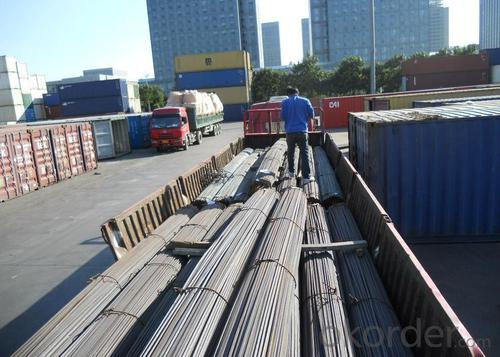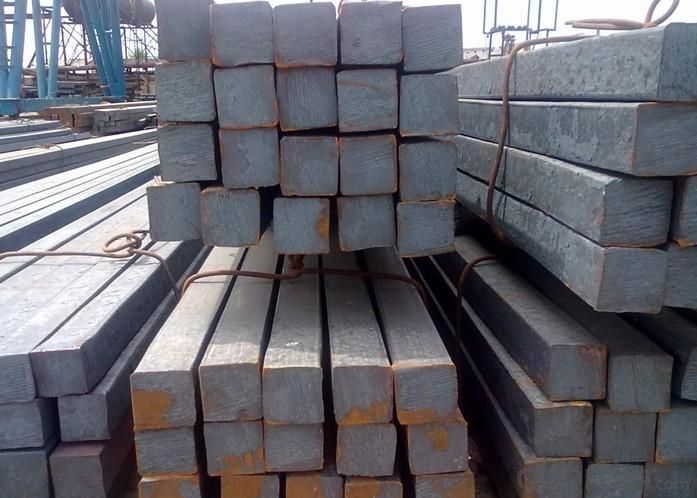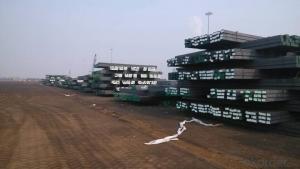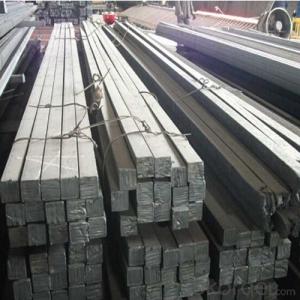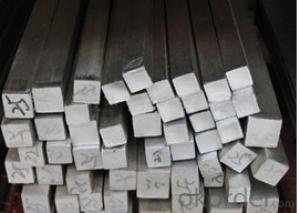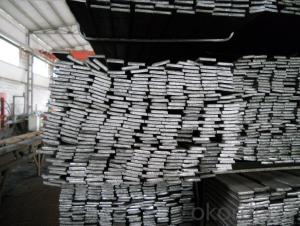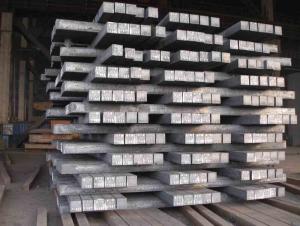Hot Rolled Square Bar
- Loading Port:
- Tianjin Port
- Payment Terms:
- TT or LC
- Min Order Qty:
- 50Tons m.t.
- Supply Capability:
- 500 tons per month m.t./month
OKorder Service Pledge
OKorder Financial Service
You Might Also Like
Specifications of Hot Rolled Square Bar:
-Standard: GB,
-Grade: Q235 or equivalent.
Chemical Composition:
|
Standard |
Grade |
Element (%) | ||||
|
GB |
Q235B |
C |
Mn |
S |
P |
Si |
|
0.12~0.20 |
0.30~0.70 |
≤0.045 |
≤0.045 |
≤0.30 | ||
Measures of Hot Rolled Square Bar:

(Section of HR Square Bar)
-Length of a side and Theoretical weight of Square Bar.
|
Length of a side(mm) |
Theoretical weight(kg/m) |
Length of a side(mm) |
Theoretical weight(kg/m) |
|
6 |
0.283 |
32 |
8.04 |
|
7 |
0.385 |
*33 |
8.55 |
|
8 |
0.502 |
34 |
9.07 |
|
9 |
0.636 |
*35 |
9.62 |
|
10 |
0.785 |
36 |
10.17 |
|
11 |
0.950 |
38 |
11.24 |
|
12 |
1.13 |
40 |
12.56 |
|
13 |
1.33 |
42 |
13.85 |
|
14 |
1.54 |
45 |
15.90 |
|
15 |
1.77 |
48 |
18.09 |
|
16 |
2.01 |
50 |
19.63 |
|
17 |
2.27 |
53 |
22.05 |
|
18 |
2.54 |
*55 |
23.6 |
|
19 |
2.82 |
56 |
24.61 |
|
20 |
3.14 |
*58 |
26.4 |
|
21 |
3.46 |
60 |
28.26 |
|
22 |
3.80 |
63 |
31.16 |
|
*23 |
4.15 |
*65 |
33.17 |
|
24 |
4.52 |
*68 |
36.3 |
|
25 |
4.91 |
79 |
38.49 |
|
26 |
5.30 |
75 |
44.16 |
|
*27 |
5.72 |
80 |
50.24 |
|
28 |
6.15 |
85 |
56.72 |
|
*29 |
6.60 |
90 |
63.59 |
|
30 |
7.06 |
95 |
70.85 |
|
*31 |
7.54 |
100 |
78.50 |
Notes:
1, The theoretical weights in the list, base on the density of 7.85 g/cm3.
2, Formula for theoretical weight of Square bar: a(length of a side) * a * 0.00785
3, The numbers with *mean that they are not regular or we don’t offer them.
-Regular length of Square Bar:
|
Steel |
Length of a side (mm) |
Length of steel (m) |
|
Normal steel |
< 25 |
4~10 |
|
> 25 |
3~9 | |
|
Steel of high quality |
All measure |
2~6 |
|
Tool steel >75 |
1~6 |
Usage/Applications of Hot Rolled Square Bar:
-The Square Steel is normally used as structure steel.
-Row material for other structure steel like steel angles, channels, I-beams, H-beams, etc…
-Row material for steel pipes.
Packaging & Delivery of Hot Rolled Square Bar:
-Packing Detail: The products can be packed in bundles by steel wires.
-Marks:
1, Tag marks: the tag marks will be tied up to each bundle of the products. The information is usually including supplier’s logo and name, product name, made in China, products’ specifications, the painted color and other information requested by customers.
2, Color marks: we will paint both ends of the bundles of these products to make sure that they are more evident. It’s will be more convenient for the customers to distinguish them at the destination port.
-Delivery Detail: 30~45 working days after receive buyer’s T.T. or L/C.
Transportation:
-The products can be delivered by bulk vessel or by container. As for container, products with the length of 6m will be loaded in 20’ container, with 9m or 12m, in 40’ container.
-The maximum quantity of loading of container is 25 tons.
-The products are usually transported to the nearest port from the production place.
Payment:
-Invoicing on theoretical weight or actual weight as customer’s request.
-FOB, CFR or CIF.
-Regular terms of payment:
1, 30% payment in advance, the remaining balance (70% payment) against the copy of B/L.
2, 30% payment in advance, the remaining balance (70% L/C) against the copy of B/L.
3, Negotiable.
Photos of Hot Rolled Square Bar:
-Products in the factory:
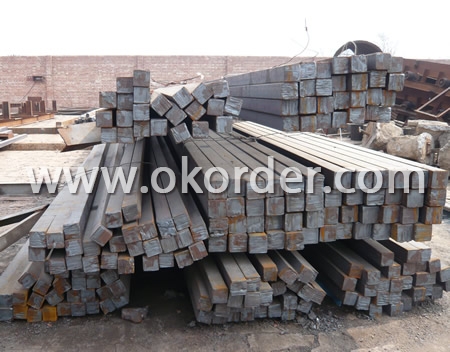
-Products during transportation:

We sincerely welcome partners around the world to establish business cooperation with us on the basis of mutual trust, benefit and development.
- Q: Can a steel square be used for plumbing and pipefitting?
- Certainly! A steel square, which is also referred to as a carpenter's square or a framing square, possesses the versatility required for plumbing and pipefitting tasks. This tool enables the measurement and marking of angles, the assessment of squareness, and the achievement of precise cuts and joints. In the realm of plumbing and pipefitting, a steel square serves the purpose of measuring and aligning pipes, executing meticulous cuts, and ensuring the appropriate angles and squareness in fittings and connections. Additionally, it proves valuable in establishing reference points and facilitating the proper installation of pipes and fixtures. Nevertheless, it is crucial to acknowledge that for more specialized plumbing and pipefitting endeavors, alternate tools specifically tailored for those tasks may prove more suitable and accurate.
- Q: Can a steel square be used for carpentry tasks?
- Yes, a steel square can definitely be used for carpentry tasks. A steel square, also known as a framing square or carpenter's square, is a versatile tool that is commonly used in carpentry. It is made of durable steel and has a 90-degree angle, as well as various other angles and measurements marked on its surface. Carpenters use it for a wide range of tasks such as measuring and marking right angles, checking for squareness, laying out cuts, and creating accurate lines and angles. It is an essential tool in carpentry that provides precision and accuracy, making it highly valuable for both professional carpenters and DIY enthusiasts.
- Q: Can a steel square be used for measuring roof pitch?
- Yes, a steel square can be used for measuring roof pitch. A steel square, also known as a framing square or carpenter's square, is a versatile tool used in carpentry and construction. It has a long blade and a shorter tongue, forming an L-shape. The blade of the square is marked with various angles and measurements, making it useful for determining roof pitch. To measure the roof pitch using a steel square, you can place the longer blade of the square along the roof rafters or trusses, ensuring that it is aligned with the bottom edge of the roof. Then, you can adjust the angle of the square until the shorter tongue rests on the roof surface. By reading the measurement on the blade where it intersects the desired pitch, you can determine the roof pitch accurately. The steel square's ability to measure angles and pitch makes it a reliable tool for determining roof slope and ensuring proper installation of roofing materials. However, it is essential to note that using a steel square may require some knowledge and practice to obtain accurate measurements. Additionally, other specialized tools, such as a digital inclinometer or a laser level, may provide more precise measurements for roof pitch in certain circumstances.
- Q: Can a steel square be used for cutting or shaping materials?
- No, a steel square is not designed for cutting or shaping materials. It is primarily used as a measuring and marking tool in carpentry and woodworking to ensure accurate right angles and straight lines.
- Q: How do you use a steel square to determine the angle of a compound fluting cut?
- In order to determine the angle of a compound fluting cut using a steel square, the following steps should be followed: 1. Begin by positioning the steel square on the workpiece, ensuring that its long side runs parallel to the edge of the material to be fluted. 2. Align one of the edges of the steel square with the material's edge, ensuring a secure hold. 3. Proceed to draw a line along the other edge of the steel square onto the material. This line will serve as a reference for the fluting cut angle. 4. Utilize a protractor or a bevel gauge to accurately measure the angle between the reference line and the desired direction of the fluting cut. 5. Once the angle has been determined, transfer it to your chosen cutting tool or machine. This can include a router, table saw, or any other appropriate tool capable of executing the fluting cut. 6. Adjust your cutting tool or machine to match the measured angle. This might involve modifying the table or fence on a table saw, or changing the angle of the router bit. 7. Before initiating the cut, double-check your setup to ensure the correct alignment of the tool or machine. 8. Finally, carefully guide the material through the cutting tool or machine, following the determined angle, to make the compound fluting cut. Always prioritize safety when working with cutting tools or machines. Adhere to the manufacturer's instructions and wear appropriate protective gear to prevent accidents and injuries.
- Q: Can a steel square be used for checking the squareness of a fence?
- Yes, a steel square can be used for checking the squareness of a fence. It is a reliable and accurate tool that can help ensure that the fence is properly aligned and at right angles.
- Q: Can a steel square be used for fence post layout?
- Yes, a steel square can be used for fence post layout.
- Q: How do you maintain and care for a steel square?
- To maintain and care for a steel square, it is important to keep it clean and free from rust. Regularly wipe it down with a dry cloth after use to remove any dirt or debris. To prevent rust, apply a thin layer of oil or rust inhibitor to the square, especially if it will be stored for an extended period. Avoid exposing the square to moisture or harsh environments. Additionally, store it in a dry place and protect it from any physical damage that may affect its accuracy.
- Q: How do you use a steel square to find the center of a square?
- To accurately locate the center of a square, one can utilize a steel square by following these instructions: 1. Begin by positioning the steel square on one side of the square, ensuring that one of its edges aligns with the side of the square. 2. Proceed to extend the edge of the steel square across the square, resulting in a mark being made on the opposite side of the square. 3. Subsequently, replicate the previous step on the adjacent side of the square, generating another mark on the opposite side. 4. The point of intersection between the two marks signifies the center of the square. To validate this, a line can be drawn connecting this point with the diagonally opposite corners of the square. By employing a steel square in this manner, one can effortlessly and accurately determine the center of a square.
- Q: Can a steel square be used for laying out a fence?
- Yes, a steel square can be used for laying out a fence. A steel square, also known as a framing square or carpenter's square, is a versatile tool that can be used for various construction and layout tasks. When it comes to laying out a fence, a steel square can be particularly useful for ensuring accuracy and straightness. It can help in determining right angles, measuring distances, and aligning posts and panels. With its sturdy construction and precise measurements, a steel square can be a valuable tool for both professional contractors and DIY enthusiasts when installing a fence.
1. Manufacturer Overview
| Location | Renqiu, China |
| Year Established | 1996 |
| Annual Output Value | Above US$ 30 Million |
| Main Markets | Mid East; Southeast Aisa |
| Company Certifications |
2. Manufacturer Certificates
| a) Certification Name | |
| Range | |
| Reference | |
| Validity Period |
3. Manufacturer Capability
| a) Trade Capacity | |
| Nearest Port | Tianjin; |
| Export Percentage | 20% - 30% |
| No.of Employees in Trade Department | 11-20 People |
| Language Spoken: | English; Chinese |
| b) Factory Information | |
| Factory Size: | Above 70,000 square meters |
| No. of Production Lines | 1 |
| Contract Manufacturing | OEM Service Offered |
| Product Price Range | Average |
Send your message to us
Hot Rolled Square Bar
- Loading Port:
- Tianjin Port
- Payment Terms:
- TT or LC
- Min Order Qty:
- 50Tons m.t.
- Supply Capability:
- 500 tons per month m.t./month
OKorder Service Pledge
OKorder Financial Service
Similar products
Hot products
Hot Searches
Related keywords



